Saturday, June 29th, 2013
By Carolyn Yeager
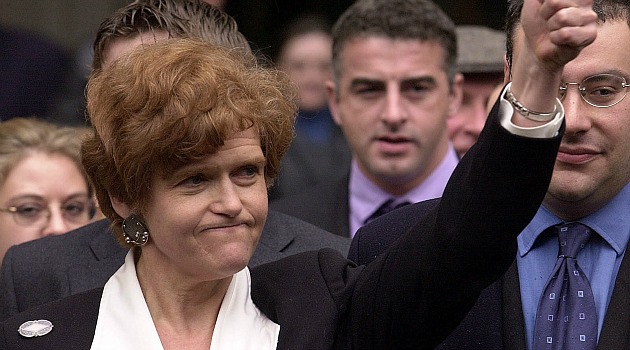
Deborah Lipstadt slammed leaders of the Claims Conference on June 26, 2013. (Getty Images)
Prof. Kenneth Waltzer used to be the man to go to when the press wanted to know what to think about any “holocaust” scandal. An example is the book, that was ready to be made into a movie, by Herman and Roma Rosenblat, Angel at the Fence. Waltzer gained a lot from his role in debunking the story (even though it was easy to do), receiving attention in the press as an “honest holocaust historian. “
Waltzer teaches German history at Michigan State University and is also director of its Jewish Studies Program since 1992 (with some time off).
When he was interviewed by Harper’s magazine about the Rosenblat fraud in December 2008, it boosted his reputation and standing. But for some time now, the only one getting the media attention is Deborah Lipstadt, professor of Jewish Studies at Emory University. I have not seen a word written, nor any kind of announcement from Waltzer about his main project for months. He spent 2011-2012 as the Winegarden Visiting Professor at UM-Flint during which time he worked with students creating their own papers to add to the overabundance of holocaust lore & trivia already in existence. [An interesting sidelight is that his students were directed to use “testimonies and memoirs” as primary sources, and “books and articles” as secondary sources. There is obviously no need for original documents in Prof. Waltzer’s classes.]
I have been scrutinizing Waltzer on the pages of Elie Wiesel Cons The World (EWCTW), not only for mistakes in his holocaust historical account, but also for deception and cover-ups. Can it be that, from this, Ken Waltzer has come to be seen as more of a liability than an asset to other holocaust historians? I can only say it is possible, and Deborah Lipstadt is one who would make such a determination faster than many others. Lipstadt is like a pitbull when it comes to fighting to keep her Jewish Holo Legend afloat; like a hound dog when it comes to sniffing out dangers to it.
Could it be that she has smelled a bad odor coming from Waltzer’s repeated screw-ups as revealed right here at EWCTW, and perhaps has even had a private “scholar to scholar” meeting with him?
Imagined Scenario
“You’re going on the sidelines, Kenny, and I will take over. I don’t want to hear a peep from you until I can assess things and come up with the way forward. Because of your stupid “Rescue of the Children of Buchenwald,” Elie may now be damaged beyond repair … and even he is not more important than preserving the integrity of our sacred Holocaust narrative. If Elie Wiesel is not more important – then you, Ken Waltzer, are certainly not!”
Lipstadt’s special relationship with the Claims Conference
In any event, Lipstadt has taken it upon herself to go after the Jewish Claims Conference officials who handed out hundreds of millions of dollars of German taxpayers’ money to fake holo survivors for 8 years before they “discovered” in 2009 what they had been warned about in 2001.
You can read about her reaction here. The failure on the part of the Claims Conference is certainly bad, but my concern here is more with why Waltzer has nothing to say about it, or why news reporters are not seeking his remarks on Lipstadt’s comments. Has Kenny been put in the dog house?
Lipstadt has come out slugging as the “honest holocaust historian” on a new “Jewish Facebook” page on June 26. She is listed as a poster on this page, along with Rabbi David Wolpe.
She wrote dismissively of the Claims Conference, saying that “No one will resign. No one will admit that they screwed up… big time.” This informs us that in spite of her show of outrage, she considers it just a screw-up … not a crime! (Jews don’t commit crimes.)
But still and all, she remains a “great fan” because of the CC support of survivors and historians. Historians?
Lipstadt said the Claims Conference funded the translation of portions of her website, Holocaust Denial on Trial, into Arabic, Farsi, Russian, and Turkish. “I remain tremendously grateful to The Claims Conference for this and other important educational and humanitarian work it has done,” Lipstadt said.
So the Claims Conference, that was instituted to provide a lifetime allowance for “holocaust survivors” who allegedly meet the requirements, also gives German taxpayer money to historians for their websites on which they promote a pro-holocaust narrative and belief. And attack those who are skeptical about it, as Lipstadt does on her “Holocaust Denial on Trial” website.
Is the Claims Conference to be a supporter of pro-holocaust propaganda, or is it to be the administrative arm for determining who is an eligible survivor? It seems to me that Deborah Lipstadt is as guilty of mishandling these funds as anyone! However, on the Claims Conference web site on the “What We Do” page we find:
We fund social services that assist elderly, needy Nazi victims, and allocate limited funds to support Holocaust education, documentation and research.
They have snuck those words into the third item of the four, after the part about funding social services for elderly, needy victims. If it’s legitimate, why do they have to sneak it? Why not make it an item of it’s own.
Lipstadt’s relationship with Ken Waltzer
On Dec. 28, 2008, Deborah Lipstadt wrote this on her blog about Waltzer’s work:
“Professor Ken Waltzer, who did the research that essentially confirmed that Herman Rosenblatt’s memoir was fabricated, has issued the following statement. It is exceptional in its sensitivity and its focus on the real culprits in this entire messy saga.
I have learned tonight that Penguin Berkley Press has pulled the memoir, Angel at the Fence, which I and others have been investigating, from publication. Herman Rosenblat has shared the news that he invented the false story with Harris Salomon, president of Atlantic Overseas Pictures, and Harris Salomon has told the publisher. Penguin Berkley Press will seek restitution. [The second sentence is awkwardly written, something that is common in Waltzer’s writing, showing he was not well educated before his admission to the graduate History program at Harvard. You decide for yourself how he got in. -cy]
I am saddened by the whole thing. First, Herman and Roma Rosenblat are of course to be faulted for making up a Holocaust love story and seeking fame and public attention, but their lying and dissimulating are actually understandable. Less understandable is the widespread belief in their story by the culture makers, including the publisher and movie maker and many thousands of others who have encountered it over a decade.
Second, such belief suggests a broad illiteracy about the Holocaust and about experience in the camps — despite decades of books, serious memoirs, museums, and movies. This shakes this historian up.
This memoir was at the far end of implausibility, yet until yesterday, no one connected with packaging, promoting, and disseminating it asked question about or investigated it. It is same with Elie Wiesel, exactly! Some actively resisted such investigation and tried to shut mine down. [Yes, indeed, investigation into Elie Wiesel’s Night is just as necessary as into the Rosenblat story.-cy]
The idea of a prisoner autonomously going to the fence daily, every day, in a Nazi concentration camp and meeting a young girl at the guarded, electrified fence who was allegedly hiding under false identity with her family in the nearby village and who threw him food beggars the imagination. Prisoners in konzentrationslager could not approach guarded fences; persons in hiding with a primary family group would not risk detection by going daily to a camp where SS guards were concentrated. The actual fence in Schlieben was right next to the SS barracks.
So Herman and Roma overreached and actually demeaned their own Holocaust stories — Herman forgot his brothers who kept him alive in the camps, Roma forgot her own remarkable and sad family story hiding not in Schlieben but elsewhere more than 200 miles away.
But where were the culture makers on this one? What kind of questions did Penguin Berkley Press bring to bear regarding a memoir about a love story set in a concentration camp? What kind of strategy did Harris Salomon embrace to elevate a candy coated Holocaust love story to bring Holocaust education to Middle America? This was not Holocaust education but miseducation. Holocaust experience is not heartwarming, it is heart rending. All this shows something about the broad unwillingness in our culture to confront the difficult knowledge of the Holocaust. All the more important then to have real memoirs that tell of real experience in the camps. [But real memoirs are called Holocaust Denial by D. Lipstadt! -cy]
I want to thank those who have worked with me – particularly forensic genealogists Sharon Sergeant and Colleen Fitzpatrick, and amateur Schlieben historian Uwe Schwarz and his associate Jean-Luis Rey. I also want to thank the many survivors, including Ben Helfgott and Sid Finkel, who put their trust in me and shared their knowledge. Gabe Sherman’s reportage at the New Republic has been remarkable, and there will be more to say in the coming days. [See all the help he needs! LOL -cy]
Ken Waltzer
Director, Jewish Studies
Michigan State University
Finally, a podcast produced by Lipstadt’s denial website:
It carries no date, but would be from 2008-09, or early 2010 at the latest! The interviewer’s name was Leshem.
Q. [Leshem]
Finally, finally, can you just tell us what the title of your forthcoming book is and when we might expect it?
A. [Waltzer]
Well, I’ve got probably another year of writing to go. [At that time! So what happened? Give an explanation please. Where is the book?] The current title is The Rescue of Children and Youths at Buchenwald, and it tells the story of the communist-led underground in the camp who in ’43 and ’44 evolved a response to the rise of young children and youths inside Buchenwald. They tried to protect them; they tried to increase the likelihood or probability that they would endure until the end of the war. They did it in an ad-hoc (very specific) way because they didn’t have control of the transports and they didn’t know who, or what number, would be coming. And initially they didn’t save very many. Many were sent to the outlying camps and died doing harsh work. [How does he know?] But from summer of ’44 on, against the backdrop of the Allies coming closer from both East and West, which the underground knew about, the underground kept large numbers of boys inside the camp, kept them from being sent out to the outlying sub camps, sheltered them in barracks under underground control — a kind of tough love disciplined control — and gave them access to extra clothing and food, and even in a couple of cases in some barracks conducted schools that lifted their minds beyond the everyday nastiness of the camp. [This all comes from testimony – not under oath – of communists, jews, and communist Jews, not from records. Furthermore, it would not have been possible, and also was not necessary.]
And as a consequence, that helps answer the question how it is that there were 904 boys alive to be liberated when Patton’s army showed up. They had been nurtured, protected, and helped to be made safe by older men, including Communists from Germany, Czechoslovakia, and Hungary, and a Polish-Jewish element that worked with the underground to help save the boys. [You see how they have to credit themselves for the survival of youngsters because it doesn’t fit their overall extermination narrative. Yet, the youth were looked after because the German camp administration saw to it that they were looked after. Following the “liberations,” all the German personnel were killed or arrested or were forced to flee, thus the “victims” could tell any story they wished. If there were any honest ones, they were soon silenced. -cy]
2 Comments
Category Featured | Tags: Tags: Deborah Lipstadt, Emory University, Herman and Roma Rosenblat, holocaust memoirs, Jewish Claims Conference, Jewish Facebook Page, Michigan State University,
Social Networks: Facebook, Twitter, Google Bookmarks, del.icio.us, StumbleUpon, Digg, Reddit, Posterous.
Tuesday, June 11th, 2013
[Continuation from “Is it time to call Ken Waltzer a fraud?“]
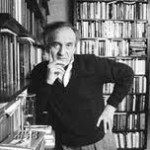 by Carolyn Yeager
by Carolyn Yeager
copyright 2013 carolyn yeager [last updated 12-5-2015]
“In literature, Rebbe, certain things are true though they didn’t happen, while others are not, even if they did.” –Elie Wiesel speaking of his book Night, from his Memoir: All Rivers Run to the Sea
For the skeptics and know-nothings who have written in suggesting Eli Wiesel was not in the camps, that Night is purely fiction, you are all dead wrong. The Red Cross International Tracing Service Archives documents for Lazar Wiesel and his father prove beyond any doubt that Lazar and his father arrived from Buna to Buchenwald January 26, 1945, that his father soon died a few days later. –Kenneth Waltzer in a comment at Scrapbookpages Blog, March 6, 2010.
The story that Michigan State University history professor Kenneth Waltzer has told us about Elie Wiesel in Buchenwald, based on Wiesel’s book Night, is not true.1
Elie Wiesel was not incarcerated at Buchenwald.
He was not liberated from Buchenwald.
He was not a victim of the “Nazis” there.
How do we know that?
Well, how do we know that Elie Wiesel was at Buchenwald?
1. We have a numerical file (registration) card for Lazar Wiesel from Sighet, born 1913.
2. We have a questionaire (Fragebogen) made out for and signed by a Lázár Wiesel, a 16-year old Jew from Sighet.
3. We have a transport list from Buchenwald to France with the name Lazar Wiesel, born Oct. 4, 1928.
4. We see a picture of him in the famous photograph taken in Barracks #56 on April 16, 1945.
5. We have a death report for Abraham Viezel (not Schlomo or Solomon) on 2-2-1945, in Block 57.
6. We have a transport list from Auschwitz to Buchenwald with the names Lazar Wiesel, #123565, born 4 September 1913 and Abram Viezel, #123488, born 10 October 1900.
7. We have a photo of the “rescued children” marching out of the Buchenwald main gate on April 27, 1945.
8. We have the book Night, in which he says he was.
* * *
The above list is ordered according to its perceived importance in proving Wiesel was at Buchenwald, so I’ll start from the bottom (least important) in showing that they don’t prove any such thing.
8. The persuasiveness of the book Night has been dealt with in several other places, for example here and here, and is not considered evidence.
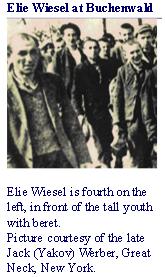 7. Photo of Buchenwald Boys (scroll down a bit). The boy that Ken Waltzer has identified as Elie Wiesel (who was identified to him as such by Jack Werber of Great Neck, NY, a “holocaust survivor” activist) is clearly not Wiesel and has not been identified as Wiesel by anyone other than Ken Waltzer. Waltzer had this image/blurb, at right, on his MSU website for years [the site was removed sometime in 2012], making him look foolish. Will Waltzer admit that he was wrong all this time, or try to sweep it under the proverbial rug?
7. Photo of Buchenwald Boys (scroll down a bit). The boy that Ken Waltzer has identified as Elie Wiesel (who was identified to him as such by Jack Werber of Great Neck, NY, a “holocaust survivor” activist) is clearly not Wiesel and has not been identified as Wiesel by anyone other than Ken Waltzer. Waltzer had this image/blurb, at right, on his MSU website for years [the site was removed sometime in 2012], making him look foolish. Will Waltzer admit that he was wrong all this time, or try to sweep it under the proverbial rug?
6. The Transport List to Buchenwald only proves that Lazar Wiesel, age 31 (a locksmith by trade) and Abram Viesel, age 44, arrived at Buchenwald on January 26, 1945 from Auschwitz. See here and here. Elie’s father’s name was Solomon (Schlomo); he never went by Abram, nor did Elie ever go by “Lazar.” Lazar had been given the Buchenwald number 123565, while Abram had 123488. There is no honest way to turn these two into Eliezer Wiesel and his father. Both the birth dates and the names are wrong. It only proves that Elie Wiesel claimed for himself the Auschwitz prisoner number (A7713) of another man. Where is the tattoo on Elie’s arm that reads A7713?
5. The Death Report for Abraham Viezel, Buchenwald prisoner number 123488, same as on the transport list. His death is recorded as taking place in Block 57 on February 2, 1945, not Jan. 29, 1945 as is clearly stated in Night for Eliezer’s father.2
4. The Famous Liberation Photo taken at Buchenwald on April 16, 1945 is said to show Elie Wiesel among the men in the bunks. Beside the fact that the face pointed out as Elie’s doesn’t look like him (for reasons which have been made clear here and here) and that he did not identify himself in it until 1983 when the campaign to get him a Nobel Prize began, there is also his hospitalization which began on April 14th.3 He could not have been near death in a hospital and in the picture at the same time! Ken Waltzer took the liberty of changing the date the photo was taken to April 12 or 13th to get around that inconvenient fact.4
3. The Transport List to France. When did Elie Wiesel’s birthday change to Oct. 4th from Sept. 30th? A majority of boys on this list share the birth year of 1928. The person listed as Lazar Wiesel is the same Lazar Wiesel that the Questionaire refers to, but we have determined that this person could not have been Elie Wiesel. It is true that Elie Wiesel went to France, but how he got there, and when, is not clear.
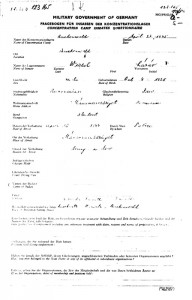 2. The Questionaire [scroll down page] was apparently prepared for and signed by every prisoner prior to their release. It is dated April 22, 1945; the prisoner number is 123165, different by one digit from our previous Lazar Wiesel #123565, and is the number belonging to a recently deceased inmate, Pavel Kun,5 whose death is recorded as March 8, 1945. Since Elie Wiesel allegedly received his number upon arrival on Jan. 26, 1945, he would not later be given a new number from a prisoner who just died. It would seem from this that Lázár Wiesel is a newcomer-of-sorts who had been given a number that had just been released.
2. The Questionaire [scroll down page] was apparently prepared for and signed by every prisoner prior to their release. It is dated April 22, 1945; the prisoner number is 123165, different by one digit from our previous Lazar Wiesel #123565, and is the number belonging to a recently deceased inmate, Pavel Kun,5 whose death is recorded as March 8, 1945. Since Elie Wiesel allegedly received his number upon arrival on Jan. 26, 1945, he would not later be given a new number from a prisoner who just died. It would seem from this that Lázár Wiesel is a newcomer-of-sorts who had been given a number that had just been released.
The name Lázár is spelled with distinct, heavy accent marks; the birth date given is Oct. 4, 1928 (Elie’s is Sept. 30); date of arrest is April 16, 1944 (Elie’s family’s deportation was at the end of May/early June – see here); the signature on the back does not match Elie Wiesel’s known signature or handwriting. The signature is also written with accents over the a’s in Lázár, implying that the accenting originated with Lázár and not with the official who filled out the form.6
But, beyond all this, on April 22 Elie Wiesel, by his own account, was in a hospital in or near Buchenwald camp “hanging between life and death” after coming down with severe food poisoning. He was taken to the hospital on April 14 and not released until April 28, according to his own words in his “autobiographical” Night and his 1995 memoir All Rivers Run to the Sea. Therefore, he could not have been interviewed or signed the questionaire on April 22nd. (See Endnote 3)
1. The Numerical File Card (below), made out at registration, is for Lazar Wiesel from Maromarossziget, born Sept. 4, 1913, making him at the time 31 years old. His Buchenwald prisoner number 123565 is written on the upper right. The card indicates his father, Szalamo Wiesel, was also at Buchenwald, while his mother, Serena Wiesel, nee Feig was currently interned at KL Auschwitz (at the time of Jan. 26, 1945).
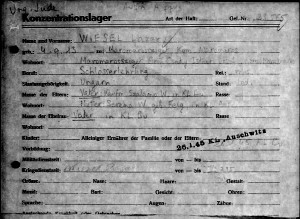 This registration card is the only item that casts some doubt7 over Nikolaus Grüner’s account of Lazar and Abram. But it does not prove that this Lazar Wiesel is Elie Wiesel. It does not make any sense that all the birth dates for the same person would be different! It makes more sense that there were several persons with similar names.
This registration card is the only item that casts some doubt7 over Nikolaus Grüner’s account of Lazar and Abram. But it does not prove that this Lazar Wiesel is Elie Wiesel. It does not make any sense that all the birth dates for the same person would be different! It makes more sense that there were several persons with similar names.
Note that this card identifies Lazar Wiesel as a locksmith (Schlosserfehrling), a trade of which the 15-year-old Elie Wiesel never would have identified himself. In Night he identified himself upon entry to Auschwitz as “a farmer” (p. 32, MW translation) and continued not to boast of any skill (of which he had none anyway) so as not to be sent out for work.
* * *
So we end up realizing there is no evidence that Elie Wiesel ever set foot in Buchenwald in 1945. What’s more, he and others (including Ken Waltzer) have actively and knowingly lied about photographs, dates, times, names, etc. This has gone on with the blessing and support of Yad Vashem Holocaust Memorial in Israel, the US Holocaust Memorial Museum in Washington DC, the New York Times Company, Associated Press, and other establishment media – and the multitude of Jewish/Holocaust-promoting organizations across the globe. Think of Elie Wiesel conducting US President Obama and German Chancellor Merkel around the Buchenwald Memorial in 2009! It is a giant criminal conspiracy when one really takes a look at it. The ramifications are immense.
Someone, preferably Elie Wiesel, needs to explain all the discrepancies in his tale. He has never offered to and never been asked to. If Wiesel won’t attempt an explanation, then Ken Waltzer the Historian with the PhD from Harvard University must do so. In his scholarly studies, Waltzer includes Elie Wiesel as one of the “Rescued Children of Buchenwald. ” One duty of a scholar is to answer serious and justified questions about their work. Elie Wiesel Cons The World is asking such questions and so we await an answer.
Update 6-15 Great idea from a reader: Write to Prof. Ken Waltzer at [email protected] and ask him politely to answer the questions raised in this article.
Endnotes:
1. Prof. Kenneth Waltzer has removed this article from the Internet, along with his entire website which the article had been a part of for several years, and says he has written a new separate article on Elie Wiesel in Buchenwald.
The book is on track, and I have also completed a separate essay to be published on Elie Wiesel and Buchenwald. -Ken Waltzer to me, Carolyn Yeager, in an email, March 2013
He obviously doesn’t want comparisons made between his old and new article and is waiting as long as possible to make it public. Or is he still reworking it?
2. “Then I had to go to sleep. I climbed into my bunk, above my father, who was still alive. The date was January 28, 1945. I woke up at dawn on January 29. On my father’s cot there lay another sick person. They must have taken him away before daybreak and taken him to the crematorium.” –Night, 2006 Marion Wiesel translation, p. 112
The Yiddish original, Un di Velt Hot Gesvign, says Father’s death occurs on the 18-19 of Shevat:
For a couple of hours I stayed by him and looked at his face long and well […] Then they forced me to go lie down to sleep. I climbed up to the uppermost bunk and I did not know that in the morning, on awakening, I would find my father no more.
It was the eighteenth of Shevat, 5705.
Nineteenth of Shevat. Early in the morning.
I got up and ran to my father. Another sick man was lying in his place.
I had a father no more. (p 238)
Readers might be surprised to learn that the Hebrew calendar date of 18-19 Shevat, 5705 corresponds to February 1-2, 1945. This gives credence to the idea that Abram Viezel’s death is the model for the story And The World Remained Silent. The date in the original story for Father’s death and the date of Buchenwald records for Abram’s death concur. This leads me to question Elie Wiesel’s personal knowledge of events at Buchenwald because why would he change the date to Jan. 28-29 if he knew the significance of Feb. 1-2?
Also, the death took place in Block 57, the report said, which would seem to be next door to Block 56 where the famous Buchenwald liberation photo is said to have been taken.
3. “Three days after the liberation of Buchenwald, I became very ill: some form of food poisoning. I was transferred to a hospital and spent two weeks between life and death.” –Night, 2006 Marion Wiesel translation, p. 118
Also in Un di Velt Hot Gesvign (the original Yiddish story from which Night was taken), p.244:
“Three days after liberation I became very ill; food-poisoning. They took me to the hospital and the doctors said that I was gone. For two weeks I lay in the hospital between life and death. My situation grew worse from day to day.”
Another question that occurs is: Of all the photos taken in Buchenwald after liberation, why don’t we find even a single one with Elie Wiesel in it? Knowing he wasn’t there at all may be why he liked the food poisoning/hospitalization story – it can explain why he doesn’t show up in any photograps. But it totally contradicts his “evidence” of the Questionaire and of his being in the famous barracks #56 photo.
4. Waltzer wrote in his article:
“He [Elie] was too weak at liberation on April 11 to leave his barracks (hence he was photographed in a famous picture in the barracks on April 12 or 13), and he came to understand he was free only days later.”
Waltzer trapped himself again. The officially declared date of the photo is April 16, which is well established. Waltzer is simply trying to evade with lies the serious problem of Wiesel going into the hospital 2 days before the photo was taken. This is NOT how a respectable, responsible historian does things.
In addition, Waltzer is saying that the photograph was taken in the children’s barracks #66, which is utterly wrong. The official description says it was barracks #56, for men, or possibly a sick barracks. If Abram Viezel was in a sick barracks when he died (#57), then #56 might also be an “infirmary” barracks.
5. Pavel Kun is on the transport list of Jan. 26, 1945 from Auschwitz to Buchenwald. He appears under the section Politische Slowakan Juden; his birth date is July 6, 1926, making him 18 when he died.
6. Revisionist Carlo Mattogno concluded, after studying these documents, that Lazar Wiesel, Lázár Wiesel and Elie Wiesel are not the same person.
In conclusion, we can say that Elie Wiesel can be neither Lazar Wiesel, nor Lázár Wiesel, nor Lazar Vizel and that the ID number A-7713 was not assigned to him but to Lazar Wiesel, while ID A-7712 was not assigned to his father but to Abram (or Abraham) Viesel (or Wiesel).
The charge of identity theft raised against Elie Wiesel by Miklos Grüner does not concern Lazar Wiesel only, but Lázár Wiesel as well: from the former, he took the Auschwitz ID number (A-7713), from the latter the stay at Buchenwald and the later transfer to Paris. –http://revblog.codoh.com/2010/03/elie-wiesel-new-documents/#more-837
7. Szalamo seems likely a Hungarian spelling for Shlomo. Serena Feig is close but not Elie’s mother’s name, which was Sarah Feig. According to this card, Lazar had a father in the camp, something that was not mentioned by Nikolaus Grüner. Ken Waltzer will say this proves that Lazar Wiesel is Elie Wiesel, but what about the very wrong birthdate? Why don’t we have a card for Szalamo too? These cards are kept at Bad Arolson, not at the Buchenwald Memorial Museum Archive; only people with special permission (like Waltzer) have access to them.
17 Comments
Category Featured | Tags: Tags: Abramham Viezel, Buchenwald Boys, Buchenwald liberation, Elie Wiesel. Buchenwald Concentration Camp, Kenneth Waltzer, Lazar Wiesel, Night, Rescued Children of Buchenwald,
Social Networks: Facebook, Twitter, Google Bookmarks, del.icio.us, StumbleUpon, Digg, Reddit, Posterous.
Tuesday, June 4th, 2013
By Carolyn Yeager
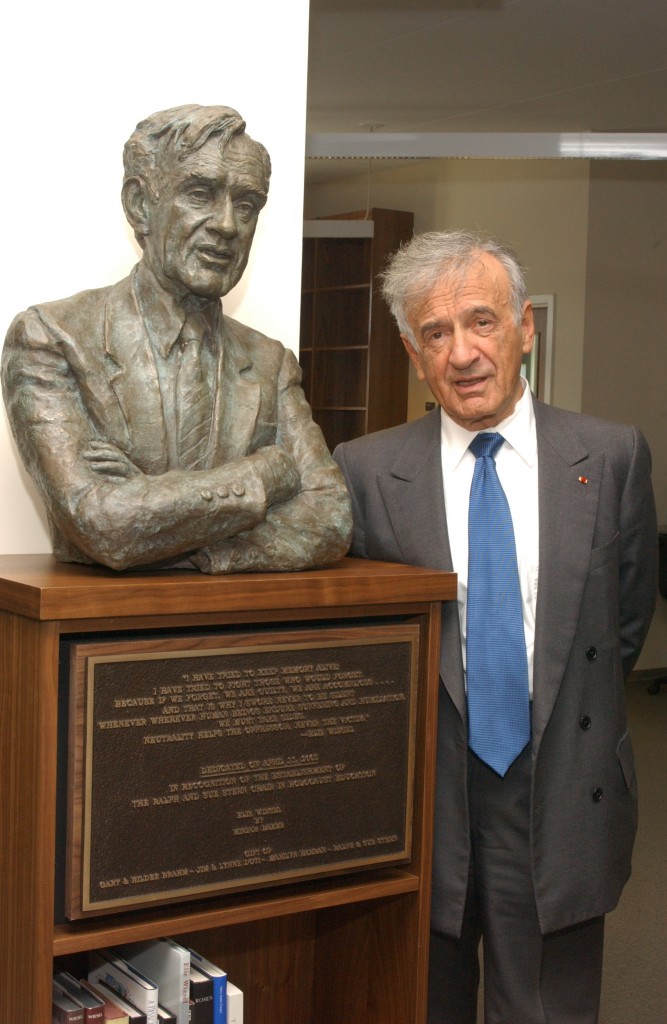 Elie Wiesel did not have a visit with Chapman University students this spring. Up until this year, he had completed only two years of his five-year appointment as a Distinguished Presidential Fellow at the university. 2013 would have been year three. Wiesel previously arrived at the end of March or in April for about five days. Now it is already June and school is out.
Elie Wiesel did not have a visit with Chapman University students this spring. Up until this year, he had completed only two years of his five-year appointment as a Distinguished Presidential Fellow at the university. 2013 would have been year three. Wiesel previously arrived at the end of March or in April for about five days. Now it is already June and school is out.
I searched the March 2013 archives of The Panther, Chapman U’s student-run newspaper, and found nothing. It always covered Wiesel’s visits in the past.
The last public appearances that I know of are his speech at Kent State University in Ohio on April 11th, and his participation in the U.S. Holocaust Memorial Museum (USHMM) 20th anniversary on April 28-29, during which he had to meet lots of people. He looked frail at both events and I imagine he didn’t think he had the energy for more than those.
I have a suspicious thought, however, that he simply ran out of anything of even pretend-value to say to young students, and is now begging off his 5-year appointment. I think at the time, shortly after the Bernard Madoff scandal broke, Wiesel felt he needed money and the California Jewish funders of Chapman University’s holohoax wing came up with this idea. Wiesel grabbed it, but now doesn’t care as much, being that his son is a Vice-President at Goldman Sachs. He’s probably made up his losses already.
Wiesel had heart by-pass surgery last year, about which he wrote a book, naturally. So though he shouldn’t be having heart trouble, we may be seeing quite a bit less of him from now on. At 84, he needs to conserve his energy.
Pictured right: Elie Wiesel in younger days poses with a large bronze bust of himself that adorns the entrance to the Sala and Aron Samueli Holocaust Memorial Library at Chapman University. It opened in April 2005 and is like a little holocaust museum right there on university grounds.
* * *
I have updated the Page titled “Famous Photo of Buchenwald Survivors”, which is accessed under “The Evidence” > “Photographic Evidence” on the upper menu bar. I hope you will take a look at it. I’ve added quite a bit to what was there, and also removed some things that I no longer agree with.
This photograph is an amazing study in the use of photo-montage and general photo-manipulation by the U.S. Army OSS, and the false claims by “survivors” to be in the picture. In many cases, it seems to be mainly ego-gratification–to claim to be in an iconic image representing an important historic time of one’s people. But there is also in some cases a desire to add one’s own “witness” to the false ideas attributed to Buchenwald–a climbing on, so to speak. Such a willingness to bald-face lie is hard for non-Jewish people to fathom.
No Comments
Category Featured | Tags: Tags: Bernard Madoff, Chapman University, Distinguished Presidential Fellow, Elie Wiesel, Famous Photo of Buchenwald Survivors, Goldman Sachs,
Social Networks: Facebook, Twitter, Google Bookmarks, del.icio.us, StumbleUpon, Digg, Reddit, Posterous.







